| Author |
Message |
Rodolfo Martínez

|
 Posted: Fri 10 Aug, 2007 11:23 am Post subject: Close Helmets and Armets Posted: Fri 10 Aug, 2007 11:23 am Post subject: Close Helmets and Armets |
 |
|
Hello guys.
Wew!It has been a long time no stop around.
I was looking some armets and close helmets and a guy told me that close helmets didn´t evolved from armets so, Is that true?
What is the main difference between both helmets?
Did close-helmets met battle during the first half of the XVI century?
Thanks a lot guys.
P.D.
About the armour... I Think it is Maximilian style, but, What style do you think it is, French, Italian?
When do you think it was manufactured?
 Attachment: 28.14 KB Attachment: 28.14 KB
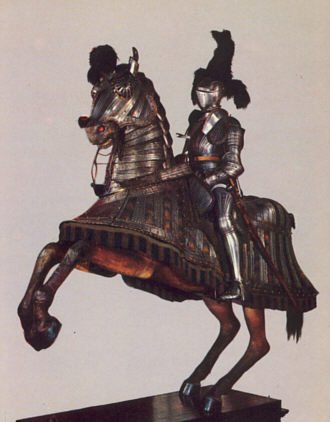
¨Sólo me desenvainarás por honor y nunca me envainarás sin gloria¨
Last edited by Rodolfo Martínez on Fri 10 Aug, 2007 8:40 pm; edited 1 time in total
|
|
  |
 |
Torsten F.H. Wilke

Location: Irvine Spectrum, CA Joined: 01 Jul 2006
Posts: 250
|
 Posted: Fri 10 Aug, 2007 7:13 pm Post subject: Posted: Fri 10 Aug, 2007 7:13 pm Post subject: |
 |
|
From what I can ascertain, it seems that close helmets got their beginnings from the workings of Italian bellows-visored sallets and hinged Great Bascinets in the last third of the fifteenth century. Armets seemed to exert an influence on the artistic styling of the bevor, visor, and neck portions of the close helm. Less so on a Max style close helm, which was more strongly rooted in the Italian bellows-visored sallet. It may seem that the close helm was a conglomeration of the most functional and effective parts of the various earlier helm styles, a natural Darwinian progression if you will...
The armour - My guess is French around 1525 to 1535.
|
|
  |
 |
Rodolfo Martínez

|
 Posted: Fri 10 Aug, 2007 8:45 pm Post subject: Posted: Fri 10 Aug, 2007 8:45 pm Post subject: |
 |
|
Thanks Torsten. I didn´t imagine that French armours were so nice, i though that French knights mostly used Maximilian armours . Just for curiosity, is there any site showing French armours? (Ca.1500-1550)
I have seen a lot of late XVi century close-helmets and they are really nice, but i havan´t seen to much early examples, so If i´m not asking to much i would like to ask how this early close-helmets (Ca.1500-1550) looked like?
Thanks.
¨Sólo me desenvainarás por honor y nunca me envainarás sin gloria¨
|
|
  |
 |
|
Roland Rich
Location: New Zealand Joined: 21 Feb 2004
Posts: 1
|
 Posted: Fri 10 Aug, 2007 9:29 pm Post subject: Posted: Fri 10 Aug, 2007 9:29 pm Post subject: |
 |
|
According to 'Arms and Armour of the Medieval Knight' armets are an early form of close helms and first appear in the fifteenth century.
The main difference between the two helms seems to be their construction and attachment of their bevor:
- The bevor of an armet is split in the middle, with the two halves hinged at the cheek. The two pieces then open outwards.
- The bevor of a 'true' close helm is in one piece and shares the pivot point with the visor, and opens by swinging upwards.
In the first picture below, the one on the left is an armet, and the one on the right is a close helm (with a parade visor).
The second picture shows two earlier 15thC armets, the hinges for the cheek pieces are clearly visible.
Hope that helps explain things.
 Attachment: 29.82 KB Attachment: 29.82 KB
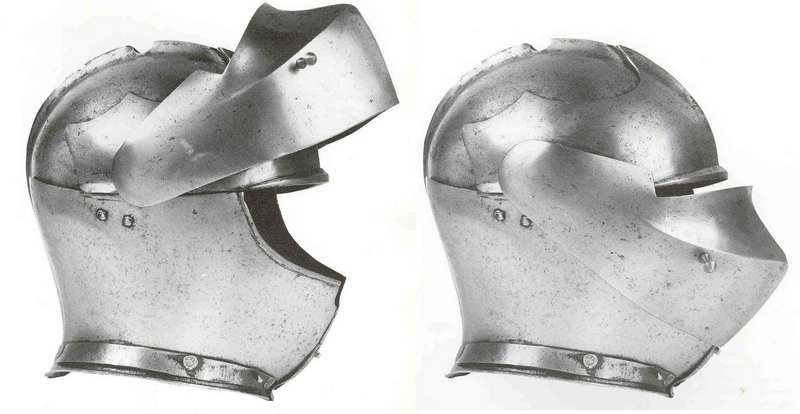
15thC armets
 Attachment: 44.41 KB Attachment: 44.41 KB
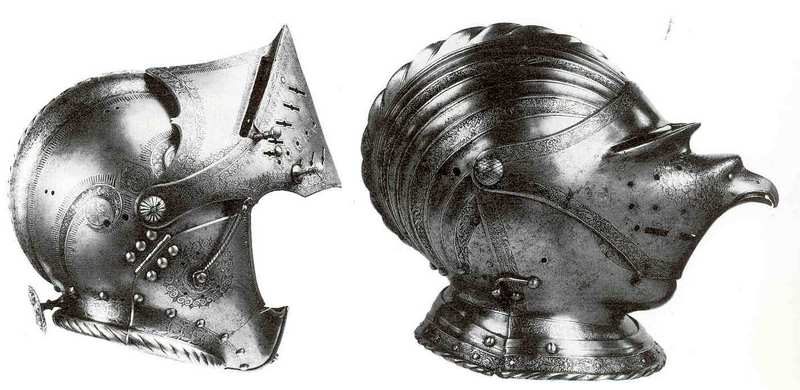
Armet on left, close helm on the right.
|
|
   |
 |
Torsten F.H. Wilke

Location: Irvine Spectrum, CA Joined: 01 Jul 2006
Posts: 250
|
 Posted: Fri 10 Aug, 2007 11:15 pm Post subject: Posted: Fri 10 Aug, 2007 11:15 pm Post subject: |
 |
|
Rodolfo, all Maximillian style close helms are late fifteenth to early sixteenth century, about 1490 to 1520. They are strongly influenced by the Italian bellows-visored sallets, not armets. The close helm at bottom right in the previous post is most likely German, from about 1520 to 1525. It would be considered a successor to the Maximillian style. The armet at bottom left in the previous post is most likely a resurgant style from the second half of the sixteenth century and influenced by English workshops. It has many characteristics of period burgeounets, as strange as that may seem.
Here are several more examples of early sixteenth century close helms from the Arsenal in Graz. They are from about 1510 to 1525, and most likely of German and Italian manufacture. They are strongly influenced by the style of armets in the mid fifteenth century, just like the one in the first photo of the previous post. These examples are the precursors of the later sixteenth century style of close helm, like the one on the harness you posted.
 Attachment: 92.82 KB Attachment: 92.82 KB
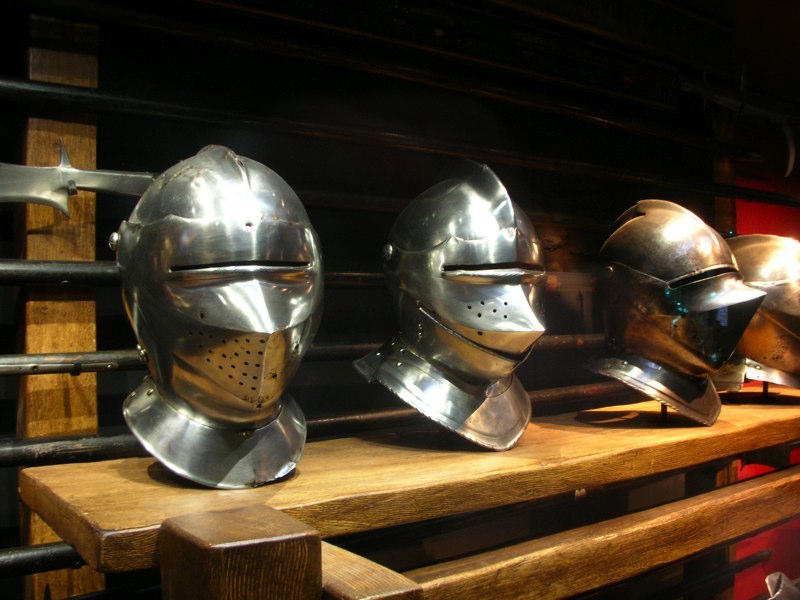
|
|
  |
 |
|
Lafayette C Curtis
|
 Posted: Sat 11 Aug, 2007 5:12 am Post subject: Posted: Sat 11 Aug, 2007 5:12 am Post subject: |
 |
|
| Roland Rich wrote: | In the first picture below, the one on the left is an armet, and the one on the right is a close helm (with a parade visor).
The second picture shows two earlier 15thC armets, the hinges for the cheek pieces are clearly visible. |
Er...it sounds a bit upside down. The picture demonstrating the armet/close-helmet seems to be the lower one...
|
|
  |
 |
Rodolfo Martínez

|
 Posted: Sat 11 Aug, 2007 3:39 pm Post subject: Posted: Sat 11 Aug, 2007 3:39 pm Post subject: |
 |
|
Thanks for the light people. I have a question about the harness... again.
After 1520 non-fluted harness started to be more common but, Are those still Maximilian, or they are of other styles?
I Just can´t see the difference between a non fluted Maximilian style armour with a 1520-1530 French or Italian suit.
¨Sólo me desenvainarás por honor y nunca me envainarás sin gloria¨
|
|
  |
 |
Hugo Voisine

|
 Posted: Sat 11 Aug, 2007 8:07 pm Post subject: Posted: Sat 11 Aug, 2007 8:07 pm Post subject: |
 |
|
| Quote: | | Thanks Torsten. I didn´t imagine that French armours were so nice, i though that French knights mostly used Maximilian armours . Just for curiosity, is there any site showing French armours? (Ca.1500-1550) |
Well, there's myArmoury.com. 
See the article about Étienne Delaune in the features section : http://www.myArmoury.com/feature_delaune.html
Some pics from the Musée de l'Armée in France : http://www.galerie.roi-president.com/photo-26...+1870.html
« Que dites-vous ?... C'est inutile ?... Je le sais !
Mais on ne se bat pas dans l'espoir du succčs !
Oh ! non, c'est bien plus beau lorsque c'est inutile ! »
|
|
  |
 |
Torsten F.H. Wilke

Location: Irvine Spectrum, CA Joined: 01 Jul 2006
Posts: 250
|
 Posted: Sun 12 Aug, 2007 11:21 am Post subject: Posted: Sun 12 Aug, 2007 11:21 am Post subject: |
 |
|
| Rodolfo Martínez wrote: | | After 1520 non-fluted harness started to be more common but, Are those still Maximilian, or they are of other styles? |
Technically, no, they are of other styles. From what I can ascertain, the Maximillian style of harness existed approximately 1490 at the very earliest to about 1525 at the latest, and these dates are really pushing the time period to the extremes. This type consisted of several styling qeues...
- An inordinately large amount of sharp fluting generally covering most pieces except for the greaves.
- Cuirasses with generously globose forms and small waists.
- Tight-fitting close helms with bellows style visors and small sallet style tails.
- Prominent shoulder-wide and very flexible gorgets.
- Well articulated boxy mitten gauntlets with almost no cuff flare.
- Sabatons with exageratingly wide toe sections
- Overall simplicity and openess for excellent maneuverability.
Some of these features were naturally adapted and incorporated into later harnesses.
Last edited by Torsten F.H. Wilke on Sun 12 Aug, 2007 11:40 am; edited 2 times in total
|
|
  |
 |
Torsten F.H. Wilke

Location: Irvine Spectrum, CA Joined: 01 Jul 2006
Posts: 250
|
 Posted: Sun 12 Aug, 2007 11:37 am Post subject: Posted: Sun 12 Aug, 2007 11:37 am Post subject: |
 |
|
| Rodolfo Martínez wrote: | | I Just can´t see the difference between a non fluted Maximilian style armour with a 1520-1530 French or Italian suit. |
Rodolfo, that difference will become quite obvious once you see the following photographs...
The first is of French examples from the link in Hugo Voisine's previous post, the second of a non fluted Max.
 Attachment: 39.57 KB Attachment: 39.57 KB
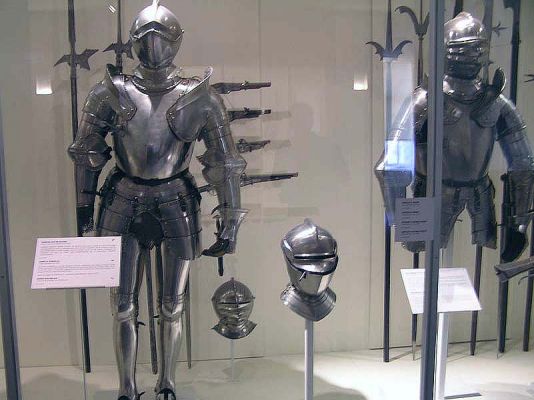
 Attachment: 75.78 KB Attachment: 75.78 KB

|
|
  |
 |
Rodolfo Martínez

|
 Posted: Sun 12 Aug, 2007 2:17 pm Post subject: Posted: Sun 12 Aug, 2007 2:17 pm Post subject: |
 |
|
Those are wonderful armours, specially Chevalier Bayard´s one, i can´t imagine how well it looked like with military skirts and plumes, sword, belt and all the stuff.
Correct me if i´m wrong, Is Chevalier Bayard´s armour wearing a Close-helmet and the other one in the same picture an talian sallet?
¨Sólo me desenvainarás por honor y nunca me envainarás sin gloria¨
|
|
  |
 |
Torsten F.H. Wilke

Location: Irvine Spectrum, CA Joined: 01 Jul 2006
Posts: 250
|
 Posted: Sun 12 Aug, 2007 11:59 pm Post subject: Posted: Sun 12 Aug, 2007 11:59 pm Post subject: |
 |
|
| Rodolfo Martínez wrote: | | ... Is Chevalier Bayard´s armour wearing a Close-helmet and the other one in the same picture an [I]talian sallet? |
Yes Rodolfo, the helm on Bayard's harness does appear to be a close helm, and not an armet. On the other hand, the second helm appears to be a bellows-visored close helm, and not immediately a sallet, nor an offshoot of a Maximillian style close helm. Closer examination of both would be required to be certain. The type of neck protection attached to the helm is a good clue.
Later period armets would have to have three way opening neck lames if they had the standard close helm look, and that is somewhat impractical in manufacture and usage. These armets therefore had a turner for the gorget as neck protection, completely dispensing with any neck lames attached to the helm itself. Sallets could easily have the standard front- and back-half neck lame layout, but the front lames would have to be attached to the visor if it were to remain a sallet and not a close helm, making it once again somewhat impractical. It is for this simple reason that we see the standard layout of the close helm becoming so successful for a century and a half. 
|
|
  |
 |
|
Gregory J. Liebau
Location: Dinuba, CA Joined: 27 Nov 2004
Posts: 669
|
 Posted: Mon 13 Aug, 2007 11:51 am Post subject: Posted: Mon 13 Aug, 2007 11:51 am Post subject: |
 |
|
| Roland Rich wrote: | According to 'Arms and Armour of the Medieval Knight' armets are an early form of close helms and first appear in the fifteenth century.
The main difference between the two helms seems to be their construction and attachment of their bevor:
- The bevor of an armet is split in the middle, with the two halves hinged at the cheek. The two pieces then open outwards.
- The bevor of a 'true' close helm is in one piece and shares the pivot point with the visor, and opens by swinging upwards. |
I would like to echo this statement, as it simply the most correct way to differentiate a proper armet from a close helm. Even helms made in the style of a Maximilian close helm, but with a split bevor, will technically be armets. Always check the bevor.
-Gregory-
My Flickr Galleries - Travel, Nature & Things
Last edited by Gregory J. Liebau on Mon 13 Aug, 2007 12:13 pm; edited 1 time in total
|
|
  |
 |
Rodolfo Martínez

|
 Posted: Mon 13 Aug, 2007 12:06 pm Post subject: Posted: Mon 13 Aug, 2007 12:06 pm Post subject: |
 |
|
Thanks Torsten
I have another question about those armour styles, Do you know if those non-fluted (French, Italian, etc...) armours were born to face the necesity of an armour wich could be made faster or something like that instead of only fashion? Because, despite being nice, fluting an armour can take a long time, and the smiths were always tampering and forging stronger armours.
Where Maximilian armours made for battle? Since when those other styles were manufactured? And how common non-fluted Maximilian armours were?
And finally, having seen some Maximilian style characteristics in Bayard´s armor and in the first armour i posted (Guessing that it is a 1520-1530 suit), just like the pauldron pattern, Why then another useful characteristics were almost dropped away in later XVI century suits, like those crest over the pauldrons(I think they are called haute piece, i don´t know, but they are in the posted armour)?
Well, really, i don´t know how practical those ¨crest¨ were for later XVI century suits, but they look awesome in earlier suits.
Thanks and sorry for the off-topic questions bombing. 
 Attachment: 31.4 KB Attachment: 31.4 KB
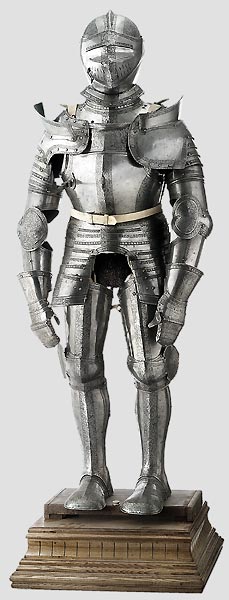
¨Sólo me desenvainarás por honor y nunca me envainarás sin gloria¨
|
|
  |
 |
Hisham Gaballa

|
 Posted: Mon 13 Aug, 2007 12:32 pm Post subject: Posted: Mon 13 Aug, 2007 12:32 pm Post subject: |
 |
|
I think you may have the wrong impression. 
"Non-fluted" armours were probably the norm and fluted "Maximillian" armours were a variant. It just so happens that more fluted armours seem to have survived.
Here is probably one of the most famous "non-fluted" armours, it the Armour of king Wladislas of Bohemia, a German armour which dates to around 1510 AD:
 Attachment: 114.77 KB Attachment: 114.77 KB
[ Download ]
|
|
  |
 |
|
Gregory J. Liebau
Location: Dinuba, CA Joined: 27 Nov 2004
Posts: 669
|
 Posted: Mon 13 Aug, 2007 12:53 pm Post subject: Posted: Mon 13 Aug, 2007 12:53 pm Post subject: |
 |
|
| Quote: | | Where Maximilian armours made for battle? Since when those other styles were manufactured? And how common non-fluted Maximilian armours were? |
I think you need to read some books, honestly. Search around for good books on late Medieval arms & armour. Your impressions on early 16th century plate seem to be getting more confused as this thread goes on. Maximilian armour is simply one style of the era. Gothic and Milanese armour both continued to evolve through this time and English styles did as well, maintaining a mix of continental styling as well as with their own unique development from the previous century. Just prior to the middle of the century a very distinct English style came out of the Greenwich armouries, which was to become pivotal to English armouring until the end of the 16th century.
Maximilian harnesses were very useful in battle, and were seen on continental fields throughout the early 16th century. We see many Maximilian suits surviving to this day due to collections such as those in the Kunsthistorisches Museum in Vienna, where harnesses and garnitures belonging to the nobility of Austria have been stored for centuries. This does not mean that they were more dominant on the fields of Europe, by any means. What we see today cannot always be reminiscent of what people saw then.
The other styles were certainly NOT made for a necessity of having more speedily crafted armour. These were more likely to be the dominant styles, but were favored by those who could not afford the advanced fluted harnesses or were out of the regions Maximilian armor influenced. Italian (based on popular 15th century "Milanese" armor), French and English armour developed just as steadily as it had in the past, always incorporating new technology as it came. These harnesses were often just as advanced in their innovative construction as Maximilian armor, but simply did not have such fluting or Germanic influence in the shaping of the pieces.
There's much to much to list, but that's a general idea, I suppose. I strongly suggest looking to books written in a professional manner to further investigate the subject. Arms & Armor of the Medieval Knight by David Edge is a wonderful place to start.
-Gregory-
My Flickr Galleries - Travel, Nature & Things
|
|
  |
 |
|
Sergei M.
|
 Posted: Sun 26 Aug, 2007 4:00 am Post subject: Posted: Sun 26 Aug, 2007 4:00 am Post subject: |
 |
|
|
Can anyone give more fotos of close helms for 1510?
|
|
  |
 |
|
|

